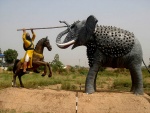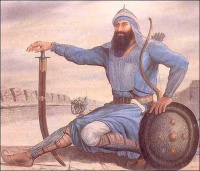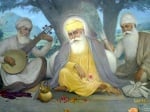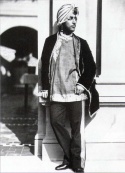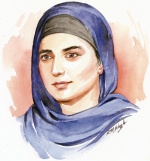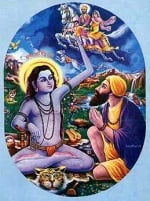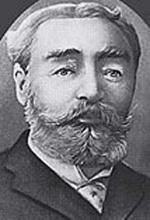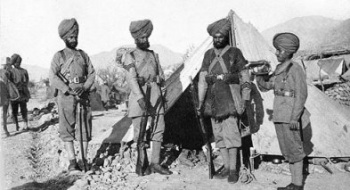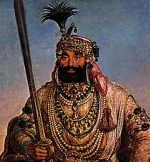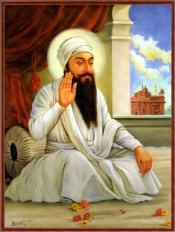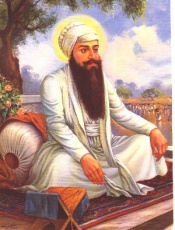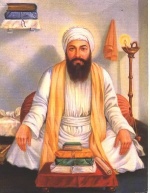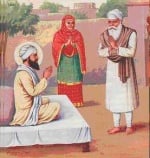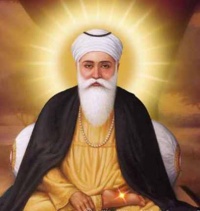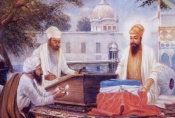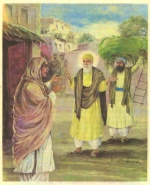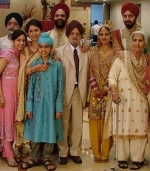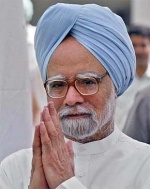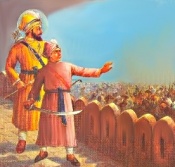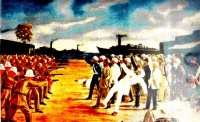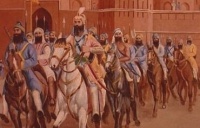SikhiWiki:Today's featured article/September 2009
Today's featured article archive
2007 -
2008 -
2009 -
2010 -
January - February - March - April - May - June - July - August - September - October - November - December
Today is Friday, April 19, 2024; it is now 19:56 UTC
Featured content:
| << | Today's featured articles for September 2009 | >> | ||||
| Su | Mo | Tu | We | Th | Fr | Sa |
| 1 | 2 | 3 | 4 | 5 | ||
| 6 | 7 | 8 | 9 | 10 | 11 | 12 |
| 13 | 14 | 15 | 16 | 17 | 18 | 19 |
| 20 | 21 | 22 | 23 | 24 | 25 | 26 |
| 27 | 28 | 29 | 30 | |||
- September 1
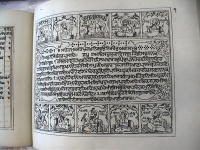
On September 1, 2004, the Sikhs celebrated the 400th year of the first installation of their holy scriptures called the Sri Guru Granth Sahib.
The Guru Granth Sahib was compiled and first installed at Harimandir Sahib (Golden Temple) in Amritsar in 1604. The holy book contains hymns written by the Sikh Gurus, saints and scholars of different religions and was completed on the 30 August 1604, it contains an important message for the whole of humanity.
The Guruship was passed to the holy Granth in 1708, some 104 year after its first installation in 1604. The holy Granth provides unique and unequalled guidance and advice for the whole of the human race. It is the torch that will lead humanity out of Kaljug, (the dark era) to life in peace, tranquillity and spiritual enlightenment for all the nations of the World.
"Guru Granth Sahib transcends creed and caste, cant and convention. It does not belong to the Sikhs alone. It consecrates the sayings of 11 Hindu bhakats and as many bard poets and seven Muslims, along with the teachings of six Sikh gurus. No other religion has included in its holy book the sayings of others, however revered." Quotation from Deccan Herald .....More
view – talk – edit – history
- September 2
Bhai Bachittar Singh (d. 1705), warrior and martyr, was the second son of Bhai Mani Ram, a Parmar Rajput and devotee of the Gurus.
One of the five brothers presented by their father for service to Guru Gobind Singh, he joined the order of the Khalsa on the historic Baisakhi day, 14 April 1699.
Subsequently, he shot into prominence during the first Battle of Anandpur against the hill chieftains, when, on 1 September 1700, he was selected by Guru Gobind Singh to single-handedly face a drunken elephant brought forth by the enemy to batter down the gate of Lohgarh Fort.
As the elephant approached the gate, Bachittar Singh, sallied forth on horseback and made a powerful thrust with his spear piercing the elephant's armour plate, injuring the animal in the forehead. The wounded elephant ran back creating havoc and great damage in the enemy's ranks. As a result of Bhai sahib's bold action, the Sikhs gained an upper hand in this conflict. .....More
view – talk – edit – history
- September 3
Baba Banda Singh Bahadur (16 October, 1670 - 9 June, 1716) (Lachhman Dev alias Madho dass Bairagi) , originally from the Jammu region, is revered as one of greatest Sikh warriors as well as a most hallowed martyrs of the Khalsa Army.
The Khalsa were engaged in a prolonged fight against the cruel Mughals, who were practising their evil tyranny and terrorism in this state in Northern India.
On 3 September 1708, at the site where Takhat Hazoor Sahib is located, Madho Das was baptised by Guru Gobind Singh1 and given the name of Banda Singh.
His subsequent confrontation with the Mughal administration in Northern India, though brief, was strong and vigorous enough to shake the foundations of this evil empire.
The brave and mighty uprising that he led in the Punjab was the underpinning on which the Dal Khalsa, the Sikh Misls and Maharaja Ranjit Singh built the foundations which finally culminated with Ranjit Singh capturing Lahore in 1799 and establishing the Sikh Kingdom in the Punjab. This was the beginning that brought an end to an extremely dark period in the history of India. .....More
view – talk – edit – history
- September 4
Bhai Kanhaiya (1648 - 1718), was a Sikh of Guru Tegh Bahadur and was the founder of the Sevapanthi or Addanshahi sect of the Sikhs. Bhai Sahib was born in a Dhamman Khatri family of Sodhara near Waxirabad in Sialkot district (now in Pakistan).
His father was a wealthy trader, but he himself being of a religious bent of mind left home when still very young and roamed about with sadhus and ascetics in search of spiritual peace. Bhai Sahib’s contribution to Sikhi:
- "Fore-runner of the Red Cross Movement,"
- "Treat all Human beings as equal"
- “Selfless service to All without Discrimination”
His quest ended as he met Guru Tegh Bahadur (1621 - 1675) and accepted initiation at Guru Ji hands. .....More
view – talk – edit – history
- September 5
Gurmat Sangeet or Shabad Kirtan has been an integral part of Sikh worship from the very beginning. Hymn-singing was in fact the earliest form of devotion for the Sikhs.
Even during the time of Guru Nanak, the disciples assembled together to sing shabads, i.e. hymns composed by the Guru which render praise to the Lord. Thus, Kirtan has been appropriated into the regular Gurdwara service for a long time.
Although Kirtan can be very touching and soul-stirring, Sikh kirtan abstains from all outward expression or frenzy in the form of clapping and dancing. Praise is offered to the Supreme Being who is without form, nirankar and not to a deity in any embodiment or incarnation.
The texts of shabad kirtan are from the Holy Book of Sikhs known as the Guru Granth Sahib, or Adi Granth, compiled by Guru Arjan in 1604 or from from the Dasam Granth and also sometimes from the compositions by Bhai Gurdas or Bhai Nand Lal. Probably no other religion shows a closer relationship between music and its scriptures than does Sikhism. The Holy Book is organized according to ragas, 31 in number, to which the poetic hymns belong. .....More
view – talk – edit – history
- September 6
Maharajah Duleep Singh (Lahore, 6 September 1838 - Paris, 22 October 1893) was a Sikh ruler of the sovereign state of Punjab, and the Sikh Empire. He was the last Maharaja of Lahore during the Sikh Raj of Punjab.
He was the youngest son of the legendary Lion of the Punjab (Maharaja Ranjit Singh) and the Messalina of the Punjab (Maharani Jind Kaur). He was also known as the Black Prince of Perthshire. He was born on September 6, 1838.
After the deaths of his brothers and nephew all of whom were Maharaja Ranjit Singh's brief successors to the Khalsa kingdom's throne. The early years of the life of Duleep Singh, the new and last Maharaja of the Punjab, were played out against the rich background of his grandfather's court and the lavish palaces and gardens of Lahore. .....More
view – talk – edit – history
- September 7
In Sikhism, the holy scriptures have clearly stated that the Sikh woman must always be regarded as an equal with man and has all the rights and privileges enjoyed by a man.
She is considered to have the same soul as man and has same right to grow spiritually.
In this faith since about 1499, the Sikh woman is allowed to lead religious congregations, to take part in:
- Akhand Path (the continuous recitation of the holy scriptures),
- to perform kirtan – Sikh spiritual hymn singing set to music,
- to work as Granthi (priest) or preacher and
- to participate freely in all religious, cultural, social, political and secular activities.
Sikh women have played a glorious part in Sikh history and have proven themselves as equal in service, devotion, sacrifice and bravery. Examples of their moral dignity, Sewa (service) and self sacrifice are and will remain an ever-lasting source of inspiration for all the peoples of the world.
Women are the backbone of the history of the Sikhs; their culture, their values and their traditions - yet there is little written about the huge contribution by the Sikh women to the great history of this religion. .....More
view – talk – edit – history
- September 8
Baba Buddha ji (6 October 1506 - 8 September 1631), one of the most venerated, primal figures of early Sikhism, was born on 6 October 1506 at the village of Katthu Nangal, 18 km northeast of Amritsar.
After sometime the family settled down in Dhalla village not far away from river Ravi opposite Kartarpur. "Bura", as he was originally named, was the only son of Bhai Suggha, a Jatt of Randhava clan, and Mai Gauran, born into a Sandhu family.
Bhai Budha occupies a unique position in Sikh history. He applied the tilak (forehead mark) of guruship to five Gurus, physically saw and had the vision of seven Sikh Gurus and remained in close association with the first six Sikh Gurus from 1521 to 1631 for over one hundred years. He was the first 'priest' (Giani) of Harimandir Sahib, and laid the foundations of Dera Baba Nanak and most of the holy buildings at Amritsar.
As a small boy, he was one day grazing cattle outside the village when, in 1521 A.D, Guru Nanak happened to pass by his village. .....More
view – talk – edit – history
- September 9
Sri Chand (9 September 1494 – 1629) was the eldest son of Guru Nanak, the founder of Sikhism.
Sri Chand was born to Mata Sulakhani on 9 September 1494 (Bhadon sudi 9, 1551Bk) at Sultanpur Lodhi, now in Kapurthala district of the Punjab. He had a reputation of saintliness, and was respected and liked by all.
Bibi Nanaki who was his aunt took in Sri Chand and adopted him as her own son. This type of arrangement was quite common and accepted custom at that time. Sri Chand became a renounced yogi.
After his father, Guru Nanak left Nankana Sahib, Sri Chand stayed in Dera Baba Nanak and maintained Guru Nanak's temple. Later he established the Udasi order, both he and his followers travelled far and wide to spread the Word of Nanak.
When Guru Ram Das met Baba Sri Chand, the Baba commented that Guru Ram Das had the longest beard he had seen. Guru Ram Das replied, "It is to wipe the feet of the saints". .....More
view – talk – edit – history
- September 10
Max Arthur Macauliffe (10 September 1841 - 15 March 1913), an English translator of the Sikh scriptures and historian of early Sikhism, was born on September 10, 1841, at Newcastle West, Limerick County, Ireland.
He was the first author to bring the Sikh faith to the attention of the "educated intelligencia" of western world.
He was educated at the Newcastle School, Springfield College and Queen's College, Galway. He received a broad humanistic education that allowed him to read the Greek and Latin classics in the original. He also read French and Italian.
At the examination of 1862 he was chosen for the Indian Civil Service and was assigned to the Punjab where he joined his appointment in February 1864. He reached the grade of a Deputy Commissioner in 1882 and became a divisional judge two years later.
His career in the Indian Civil Service has received no special historical note. Although his deep understanding and sympathy for the people of Punjab and their religious traditions doubtless made him a popular civil servant with the people of Punjab, it also brought him into conflict with his fellow Englishmen in India. .....More
view – talk – edit – history
- September 11

A peaceful, happy and contented life has become elusive for the modern man or woman!
Feelings of self worth, faith in the Omnipotent; unborn Creator; Saviour; kind, just Benefactor can be achieved by internalising the Guru’s word and hoping for His Grace.
Through His Hukam (command), His love and glory, the purpose of life becomes crystal clear and as a by-product, we start getting satisfaction in life; begin developing insights and start using tools of practical wisdom.
The Guru’s grace produces in human beings intensive elation, high level of well-being and higher and altered states of consciousness, awakened intelligence and re-appreciating of life through amazement.
Internalizing the Guru’s work makes a person return to humanity and humility. The Guru allows us to be free, to be ourselves, and to have worldly satisfaction, peace of mind and perpetual joy or (Anand). The Guru expects us to challenge the status quo, take risks, follow the righteous path by replacing the following five evil vices of the mind: kam, krodh, lobh, moh and ahankar .....More
view – talk – edit – history
- September 12
On September 12, the Sikhs worldwide will remember with honor the supreme sacrifice of their brave comrades who for the security and safeguard of their country willingly laid down their lives. The bravery of these soldiers was inspired by the heart piercing message of their tenth Guru, Guru Gobind Singh.
O God, give me these boons
that never shall I shirk from doing good deeds
that never shall I fear when I go into battle
And that with surety I shall attain victory.
by Sri Guru Gobind Singh - the motto of the Sikh Regiment
- September 13
The 300th celebration of the guruship of the holy Granth took place during 2007 to 2008. The Guru Maneyo Granth Jagriti Yatra (journey of awakening or enlightenment) of Shri Guru Granth Sahib started on 15th November 2007 from Takht Sachkhand Shri Hazoor Sahib.
15th November 2007 marked the beginning of the historical Jagriti (awakening) Yatra (journey). It lovingly showcased the shastars (weapons) of Sri Guru Gobind Singh ji Maharaj and Sri Shaheed (martyr) Singh along with puratan hast-likhit (historic hand-written) Sri Guru Granth Sahibji Maharaj. The yatra travelled to many places in India and the world. True to its name, the Jagriti Yatra created an awakening, imparting the message of One God and the importance of giving due priority to the welfare of the entire human race, irrespective of religion, colour, creed, status, caste, etc.
Since its beginning in 2007, the Yatra had been viewed by crowds in more than 100 cities throughout India — Orissa, West Bengal, Uttar Pardesh, Chattisgarh, Maharashtra, Madhya Pardesh, Himachal Pradesh, Jharkhand, Bihar, Uttar Pardesh, Uttarakhand, Haryana, Delhi and Punjab. Huge turnouts along the roadways have many times slowed the procession causing scheduled arrival times to be greatly delayed; but even the addition of pouring rains did not stemmed the crowds enthusiasm for these celebrations. .....More
view – talk – edit – history
- September 14
Maharaja Sher Singh (4 December 1807 - 15 September 1843) was a Sikh sovereign of Punjab from January 1841 until his assassination in September 1843. He was the son of Maharaja Ranjit Singh, born on 4 December 1807 to Mahitab Kaur, Maharaja's first wife.
Sher Singh grew up to be a handsome, broad-chested young man given to fashionable dress and lavish jewellery. His soldierly mien made him popular with the army. He loved hunting and hawking, and devoted attention to cultivating European interests and hobbies in the company of foreigners serving at the Sikh court.
In 1829, Maharaja Ranjit Singh conferred upon him civil and military honours and the privilege of being seated on a chair in his Darbar. Sher Singh took part in many of the campaigns undertaken by the Maharaja for the expansion of his kingdom.
In May 1831 he defeated, at Balakot in Hazara district, the turbulent Sayyid Ahmad Barelavi who had started a jihad against Sikh rule. From 1831 to 1834 he acted as governor of the province of Kashmir. In 1834 he was one of the army commanders who led forces in Peshawar and who finally seized the city from the Afghans.
In the political vacuum created by the successive deaths in November 1840 of Maharaja Kharak Singh and his son Kanvar Nau Nihal Singh, Sher Singh staked his claim to the throne of the Punjab. .....More
view – talk – edit – history
- September 15

Assu is the seventh month in the Nanakshahi calendar, which governs the Sikh tradition. The first day of the month falls on September 15.
The month of Assu coincides with September/October of the Western/Georgian/Julian Calendar and is 30 days long.
While the preceding months of Sawan (July/August) and Bhadon (August/September) are hot and rainy in Punjab, in the month of Assu both the temperature and rain subside and the season is very pleasant.
The Guru tells us that in the month of Assu (September/October): "... my love for the Lord overwhelms me. How can I go and meet the Lord?
My mind and body are so thirsty for the Blessed Vision of His Darshan. Won't someone please come and lead me to him, O my mother. The Saints are the helpers of the Lord's lovers; I fall and touch their feet. Without God, how can I find peace? There is nowhere else to go. Those who have tasted the sublime essence of His Love, remain satisfied and fulfilled.
They renounce their selfishness and conceit, and they pray, "God, please attach me to the hem of Your robe". Those whom the Husband Lord has united with Himself, shall not be separated from Him again. Without God, there is no other at all. Nanak has entered the Sanctuary of the Lord. In Assu, the Lord, the Sovereign King, has granted His Mercy, and they dwell in peace. ((8)) " (SGGS page 134-5) .....More
view – talk – edit – history
- September 16
On 16 September every year, the Sikhs celebrate the Gur Gadi day of their spiritual master, Guru Arjan Dev, the fifth Guru of the Sikhs.
Guru ji was the embodiment of Godly devotion, Selfless Service and Universal Love. He was the treasure of celestial knowledge and spiritual excellence. He substantially contributed towards the welfare of society and the formation of the Sikh faith.
He stood steadfastly for the principles he believed in, even sacrificed his own life, and attained a unique and unparalleled martyrdom in the history of mankind.
Guru Ji was born on May 2, 1563, in the house of Guru Ram Das, the fourth Guru of the Sikhs. He was the youngest of the three sons of the fourth Sikh Guru. Guru Ram Das envisioned heavenly qualities in his youngest son Arjan. From childhood Guru Ram Das found him imbued with Naam, the remembrance, love and affinity with God and always immersed in tranquil bliss.
The Guruship was destined to be bestowed upon Guru Arjan. It is said that one day, baby Arjan crawled up on the Divine throne of his maternal grandfather, Guru Amar Das the third Guru, and sat there comfortably. The Guru smiled and prophesied, “Maternal Grandson will ship the Naam across.” .....More
view – talk – edit – history
- September 17
On 16 September every year, the Sikh community worldwide commemorate the barsi (anniversary of death) of their fourth master, Guru Ram Das.
Guru ji was born at Chuna Mandi Bazaar, Lahore at the site of the present holy shrine on October 9, 1534 and spent his first seven years of life here.
Soon after birth, he was given the name Jetha, meaning the first born.
Following a Guruship of exactly 7 years starting in 1574, the Guru's youngest son, Arjan was nominated the fifth Guru, as per the famous Sakhi regarding the Sikh Bani (prayer) called Shabad Hazaray. Shortly thereafter Guru Ram Das left his physical form on September 16, 1581 in Lahore.
His simple and God-fearing parents, Hari Das and Anup Devi of Lahore were delighted at this precious gift from Waheguru. As he was growing up and in his teens, he would be found in the company of religious men. Jetha became a handsome young man. .....More
view – talk – edit – history
- September 18
Guru Angad Dev (1504 - 1552) was the second of the ten Gurus of Sikhism. Guru ji's original name was Bhai Lehna.
Bhai sahib following in the footsteps of Guru Nanak, who was the first Sikh Guru and founder of the Sikh religion became the second Sikh spiritual master on September 18 1539.
Guru Angad Dev was born on April 18, 1504 and this auspicious day is doubly celebrated by the Sikhs every year together with the birthday of their ninth master, Guru Tegh Bahadur born on April 18 1621.
The institution of langar was given prominence and further maintained and developed during the Guruship of the second master. The Guru's wife, Mata Khivi personally worked in the kitchen to prepare the food and guide others in managing this important function.
She also served food to the members of the community and visitors. Her devotion to this institution finds mention in Guru Granth Sahib, the holy book of the Sikhs.
Guru Angad also invented the present form of the Gurmukhi script. It became the medium of writing the Punjabi language in which the hymns of the Gurus are expressed. .....More
view – talk – edit – history
- September 19
BIBI AMRO was the daughter of Guru Angad, the second Sikh Master. On hearing the Gurbani shabad sang by Bibi ji, her husband's uncle Amas Das was impressed and moved to go and meet Guru Angad.
This meeting eventually lead to a lifetime of service to the panth and Guruship to Guru Amar Das, the third Sikh Guru.
Bibi Amro was born in 1532 at village Khadur near Amritsar. She had two brothers, Dassu and Datu, and one younger sister named Anokhi.
She received her early education directly from her parents. Guru Angad Dev taught her, along with the other children, to read and write in Gurmukhi script, which he had revised and simplified.
She also learnt many sacred hymns from her father. Writer of the "Bansawali Namma" tell us that she had learnt by heart sacred hymns like ‘Sidh Goshat’ and others. She had been gifted by nature with a sweet voice. In short, she was a talented girl. .....More
view – talk – edit – history
- September 20
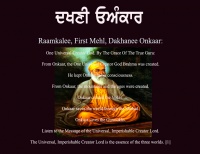
Dakhni Oankar or simply Oankar is a composition of 54 stanzas by the founder of Sikhism, Guru Nanak's in the measure Raag Ramkali in the Guru Granth Sahib. The full title of the bani is Ramkali Mahala 1 Dakhani Oankaru.
The composition appears in the holy Granth at pages 929 to 938. The title is explained differently by different scholars. The word "Dakhan" means "south" and "Oankar" is a reference to "The Creator".
This Bani (composition) is composed in the form of an acrostic, each stanza beginning with one of the letters of the Sanskrit alphabet. However, some of the sounds of the Sanskrit alphabet do not exist in the Gurmukhi language used by Guru Nanak. In such cases, prevalent equivalent sounds are used to represent the letters of the old script.
For example, 'j' is used for 'y' and 'b' for 'v'. "Oankar" opens with verses in praise of God who is remembered as the creator of all that exists; of time with all its different cycles; and of the entire universe. Then follows the verse of rahau (pause) indicating the central theme of the bani: "0 Pandit, why are you involved in the writing of such idle hieroglyphics - write the name of God alone."
After this begins the acrostic form. The emphasis is on ethical and spiritual teaching. .....More
view – talk – edit – history
- September 21
Anger or Krodh is rage, ire, wrath, irritation and annoyance. It is one of the five evils mentioned in Gurbani. It is an emotion and also a state of mind.
Anger is the feeling of antagonism, and irritation caused by some real or supposed grievance or inadequacy; it is a state of instability of the mind. It can be caused by both external and internal events.
You could be angry at a specific person (such as a co-worker or supervisor) or event (a traffic jam, a cancelled flight), or your anger could be caused by worrying or brooding about your personal problems or what someone has said or done, etc. Memories of traumatic or enraging events can also trigger angry feelings.
In the western cultures, it is believed to be a function of our primitive, animal-mode inherent self-preservation mechanisms - the confrontational aspect of what is commonly referred to as the 'fight-flight' response. Anger triggers a series of hormonal (endocrinal) changes intended to ready our body and senses for overt physical response to a potentially life-threatening situation.
"Violence, attachment, greed and anger," says Guru Nanak "are like four rivers of fire. Falling into them, one is burned, O Nanak! One is saved only by holding tight to good deeds" (GG, 147). .....More
view – talk – edit – history
- September 22
On September 22 every year, the Sikhs remember the passing away of Guru Nanak, the founder of their religion which is now known as Sikhism. The contribution of the Guru to our understanding of life and its deeper meaning is immense.
Why not learn more about the Guru's contributions to Sikhi and how this has benefited humanity. Guru Nanak was born on April 15, 1469 but each year, the Sikhs have chosen the full moon day in November to celebrate this momentous birthday.
Guru Nanak Dev came into this world at a time of extreme doom and gloom when the moral standards of the ruling class had vanished; the rulers had no respect for humanity; and law of the jungle prevailed everywhere. Men’s ideas and aspirations were at an all time low.
Materialistic wealth, plain greed and illusion of Maya fascinated the world and led everyone astray. Good acts and righteous behaviour no longer commended themselves to humans. They were burning with ego, pride and had no respect for others. The high and the low forgot their mutual duties. .....More
view – talk – edit – history
- September 23
Bhai Gurdas (1551- 23 September 16371) is a much honoured Sikh scholar, missionary and literary master who is also respected for his Sikh way of life.
He was a leading figure in Sikhism who enjoyed the company of Guru Arjan, the fifth Sikh Guru. It was under the supervision of the fifth Sikh Guru that he inscribed the first copy of Sikh Scripture, the Guru Granth Sahib, which is now respect as the perpetual Guru of the Sikhs and is central to the Sikh religion.
He was also responsible for various writings in his own right which have gained much respect in the Sikh community. His 40 Varan (Chapters) of writing have been referred to by Guru Arjan as the "Key" to the Guru Granth Sahib.
Bhai sahib was born in a Bhalla Khatri family. His father was Bhai Ishar Das and his mother's name was Mata Jivani. .....More
view – talk – edit – history
- September 24
Mata Sulakhni (1473-1545) was the wife of Guru Nanak, the founder of Sikhism. She was the daughter of Mool Chand (sometimes referred as Mul Chand Chauna), a Chona Khatri of Batala.
Mul Chand held a minor revenue office at the village of Pakkhoke Randhave in Gurdaspur district of the Punjab. Mata ji's mother's name was Chando Rani.
Sulakhani was married to Guru Nanak at Batala on 8 July 1487 (Harh 24, 1544) but this auspicious day is traditionally celebrated each year in Batala during late August.
Two sons were born to the couple - Sri Chand in 1494 and Lakhmi Das in 1497. Mata ji survived Guru Nanak and is believed to have spent the last years of her life in Kartarpur, the community that Guru Nanak had founded on the right bank of the river Ravi. She passed away at Kartarpur in 1545.
In the book, Mahan Kosh, Bhai Kahn Singh Nabha writes that a girl was born in the village Pakhoke, district Gurdaspur with "super characteristics," but neglects to elaborate what these were. He stated that she was named Sulakhani. .....More
view – talk – edit – history
- September 25
The 'family' is the basic 'atomic' structure and essential social unit in Sikhism; it is the common unit which collective forms communities. The family is the strong and noble Sikh core institution which has been promoted since the time of Guru Nanak.
It was this social unit which was most important for all the Sikh Gurus who preached the 'life of a house-holder' rather than the 'life of renunciation' which was prevalent in other cultures of the time. All the Sikh Gurus were members of the 'family unit'; all adult Sikh Gurus were married while the eighth Sikh Guru, Guru Harkrishan was a 'bala' or "child Guru".
The Gurus believed that the family unit through procreation ensures the continuation and existence of healthy societies; without the 'family unit' there is risk to the future of secure societies. In addition, the family has economic and educational functions to perform; so when family life runs in a smooth and happy manner, it creates a strong engine where societies and communities can prosper and flourish in a safe and secure environment. A strong 'family unit system' ensures a successful biological, economical and spiritual future of human societies! .....More
view – talk – edit – history
- September 26
India's fourteenth Prime Minister, Dr. Manmohan Singh is rightly acclaimed as a thinker and a scholar. He is a follower of the Sikh faith and is the first non-Hindu prime minister of India.
He is well regarded for his diligence and his approach to work, as well as his accessibility and his unassuming demeanour.
The first Sikh Indian prime minister, Singh was sworn in on May 22, 2004. He is a native Punjabi speaker. Manmohan Singh is the 14th and current Prime Minister of India, considered to be the "architect of modern India."
He was born on 26 September 1932, in Gah, West Punjab (now in Pakistan) and is a member of the Indian National Congress party.
Singh is an economist by trade, and has formerly served in the International Monetary Fund. His economics education included an undergraduate (1952) and a master's degree (1954) from Punjab University; an undergraduate degree (1957) from Cambridge University (St. John's College); and a doctorate (1962) from Oxford University (Nuffield College). .....More
view – talk – edit – history
- September 27
Sahibzada Jujhar Singh (27 September 1691 - 7 December 1705), the second son of Guru Gobind Singh, was born to Mata Jito ji (also known as Mata Sundari ji) at Anandpur on 27 September 1691 (as per Nanakshahi calendar).
Like his elder brother, Ajit Singh, he started training in the fighting skills (Gatka) as soon as he started learning the religious texts aged about 4 to 5 years. In 1699, when he was eight years old, he received holy Amrit at the rites of Khalsa initiation, called Amrit Sanskar.
By the time it became necessary to leave Anandpur under the pressure of a besieging host in December 1705, Jujhar Singh, nearing the completion of his fifteenth year, was an experienced young warrior, strong and fearless.
He was one of the band that successfully waded through the flooded Sarsa rivulet on horseback .....More +
view – talk – edit – history
- September 28
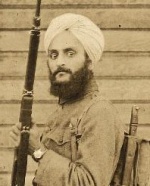
Bhagat Singh Thind, PhD, (3 October 1892 - 15 September 1967) was an Indian American Sikh writer and lecturer on "spiritual science" who was involved in an important legal battle over the rights of Indians to obtain U.S. citizenship.
Thind had fought for the U.S. in World War I. After the war he sought the right to become a naturalised citizen, following a legal ruling that "Caucasians" had access to such rights. At this time Indians were categorised as Caucasian by anthropologists.
In 1923, a crucial Supreme Court case United States v. Bhagat Singh Thind was decided in favor of the United States, retroactively denying all Indian Americans citizenship for not being Caucasian in "the common man's understanding of the term."
In the annals of Asians’ struggle for US citizenship, Bhagat Singh Thind’s fight for citizenship occupies a prominent historical place. .....More
view – talk – edit – history
- September 29
As the Komagata Maru approached Calcutta on September 26, 1914, a European gunboat signalled the ship to stop. The ship was put under guard and the passengers were held as prisoners.
Then the ship was taken to a place called Budge Budge, about seventeen miles (27Kms) away from its original destination of Calcutta.
These new developments took the passengers by surprise. After two months of litigation in Canada they were not interested in any new developments of this kind. Upon inquiry by Baba Gurdit Singh, an official informed him that the passengers were being sent to Punjab via a special train.
Many of the passengers did not want to go to Punjab. They had business to attend to in Calcutta, some wished to look for work there, and most importantly, the passengers wanted to place the Guru Granth Sahib, which they had taken with them on their journey, in a Calcutta Gurdwara. .....More
view – talk – edit – history
- September 30
Bhai Baghel Singh (1730 - 1802) was born in village Jhabal, District Amritsar in a Dhaliwal Jatt family around 1730's.
From humble beginnings he arose to become a formidable force in the area between River Sutlej and River Yamuna. He aligned himself with Karor Singhia misl led by Sardar Karora Singh. After the early demise of Karora Singh, Bhai sahib succeeded as a leader of Karora Singhia misl in 1765.
He is celebrated in Sikh history as the vanquisher of Mughal Delhi. Gurdwara Nanak Piao in Delhi was constructed by Baghel Singh
Karora Singhia misl had 12,000 fighting men according to Syed Ahmad Latif, a Muslim historian. As well as being a good soldier, Baghel Singh was a very good political negotiator and was able to win over many an adversary to his side. .....More
view – talk – edit – history
